Related Research Articles

The Federal Aviation Administration (FAA) is a U.S. federal government agency within the U.S. Department of Transportation which regulates civil aviation in the United States and surrounding international waters. Its powers include air traffic control, certification of personnel and aircraft, setting standards for airports, and protection of U.S. assets during the launch or re-entry of commercial space vehicles, powers over neighboring international waters were delegated to the FAA by authority of the International Civil Aviation Organization.
The Air Commerce Act of 1926 created an Aeronautic Branch of the United States Department of Commerce. Its functions included testing and licensing of pilots, certification of aircraft and investigation of accidents.

The Civil Aeronautics Board (CAB) was an agency of the federal government of the United States, formed in 1938 and abolished in 1985, that regulated aviation services and conducted air accident investigations. The agency was headquartered in Washington, D.C.
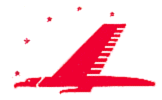
Capital Airlines was a United States trunk carrier, a scheduled airline serving the eastern, southern, southeastern, and midwestern United States. Capital's headquarters were located at Washington National Airport across the Potomac river from Washington, D.C., where crew training and aircraft overhauls were also accomplished. In the 1950s Capital was the fifth largest United States domestic carrier by passenger count after the Big Four air carriers.
Ozark Air Lines was a local service carrier in the United States that operated from 1950 until 1986, when it was purchased by Trans World Airlines (TWA). In 2001, TWA was merged into American Airlines. A smaller regional airline that used the Ozark name operated in 2000–2001. From 1950 until 1986, Ozark's headquarters was located at St. Louis Lambert International Airport.
Trans World Express (TWE) was the fully owned and certificated, regional carrier for Trans World Airlines (TWA) and an airline trademark name for TWA's corporation.
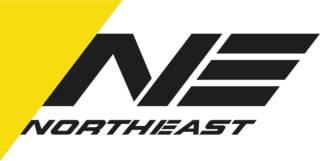
Northeast Airlines was an American trunk carrier, a scheduled airline based in Boston, Massachusetts that chiefly operated in the northeastern United States, and later to Canada, Florida, the Bahamas, Los Angeles and other cities. It was acquired by and merged into Delta Air Lines in August 1972.

Air New England (ANE) was a US regional airline in New England during the 1970s and early 1980s. It was headquartered at Logan International Airport in the East Boston area of Boston, Massachusetts. ANE was noneconomic for most of its existence. From 1975 through its last year, 1981, ANE depended heavily on government subsidies. Depending on the year, these accounted for 17 to 25% of operating revenues, despite which the airline was generally unprofitable. ANE collapsed in the early years of US airline deregulation.
Aspen Airways was an airline carrier and regional affiliate of United Express and based in Hangar 5 in Stapleton International Airport in Denver, Colorado. Aspen ceased operations on April 1, 1990, when separate portions of the airline were acquired by Mesa Airlines and Air Wisconsin Services, Inc.

Trans Caribbean Airways (TCA) was an irregular air carrier until 1957, when it was certificated by the Civil Aeronautics Board (CAB) as an international air carrier to fly from New York City to San Juan, Puerto Rico. TCA thereafter operated as a small scheduled airline specializing in flying from New York to the Caribbean, adding a small number of additional routes over time until it was purchased by American Airlines in 1971.
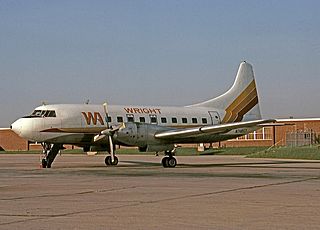
On the surface, Wright Air Lines was no different than many other many other small turboprop airlines that collapsed in the early years of the deregulated US airline industry. What set Wright apart was:

The 1955 Cincinnati mid-air collision occurred on January 12, 1955, when Trans World Airlines Flight 694 Martin 2-0-2 on takeoff from Boone County Airport collided in mid-air with a privately owned Douglas DC-3 that had entered the airport's control space without proper clearance. None of the occupants of either plane survived the collision.
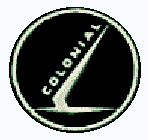
Colonial Airlines was a United States trunk carrier, a scheduled airline that operated from 1928 to 1956 with bases at LaGuardia Airport (LGA) in New York City and at Montréal/St-Hubert Airport in Montreal, Canada, before merging into Eastern Air Lines.
Mayflower Airlines was a small United States scheduled airline founded June 22, 1935 that started operations on June 15, 1936 flying from Boston to Cape Cod, Nantucket and Martha's Vineyard on a seasonal basis before World War II. Mayflower operated Stinson Model U Trimotors. The airline applied to be certificated on October 20, 1938 by the Civil Aeronautics Board (CAB) on the basis of operating scheduled service before the Civil Aeronautics Act of 1938. Certification was received by the CAB on July 31, 1940. But Mayflower did not operate after September 1939, although it had CAB approval of such suspension of service. By 1944, Mayflower was bankrupt with all of $300 in cash so in June the CAB permitted the merger of Mayflower into Northeast Airlines.
TWA Flight 3 was a twin-engine Douglas DC-3-382 propliner, registration NC1946, operated by Transcontinental and Western Air (TWA) as a scheduled domestic passenger flight from New York, New York, to Burbank, California, in the United States, via several stopovers including Las Vegas, Nevada. On January 16, 1942, at 19:20 PST, fifteen minutes after takeoff from Las Vegas Airport bound for Burbank, the aircraft was destroyed when it crashed into a sheer cliff on Potosi Mountain, 32 miles (51 km) southwest of the airport, at an elevation of 7,770 ft (2,370 m) above sea level. All 22 people on board, including movie star Carole Lombard, her mother, and three crew members, died in the crash. The Civil Aeronautics Board (CAB) investigated the accident and determined that the cause was a navigation error by the captain.

The Grand Canyon mid-air collision occurred in the western United States on June 30, 1956, when a United Airlines Douglas DC-7 struck a Trans World Airlines Lockheed L-1049 Super Constellation over Grand Canyon National Park, Arizona. The first plane fell into the canyon while the other slammed into a rock face. All 128 on board both airplanes perished, making it the first commercial airline incident to exceed one hundred fatalities. The airplanes had departed Los Angeles International Airport minutes apart from each other and headed for Chicago and Kansas City, respectively. The collision took place in uncontrolled airspace, where it was the pilots' responsibility to maintain separation. This highlighted the antiquated state of air traffic control, which became the focus of major aviation reforms.
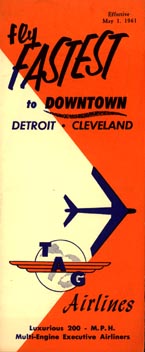
TAG Airlines was a small airline primarily serving the route from Burke Lakefront Airport in Cleveland, Ohio to Detroit City Airport, Detroit, Michigan with small aircraft. TAG achieved Civil Aeronautics Board (CAB) airline certification in October 1969 in order to fly larger aircraft on the route, only to suffer a fatal crash in January 1970 and cease operations later that year. TAG's CAB certification for the Burke Lakefront Airport to Detroit City Airport route was picked up by competitor Wright Air Lines in 1972.

The Federal Aviation Act of 1958 was an act of the United States Congress, signed by President Dwight D. Eisenhower, that created the Federal Aviation Agency and abolished its predecessor, the Civil Aeronautics Administration (CAA). The act empowered the FAA to oversee and regulate safety in the airline industry and the use of American airspace by both military aircraft and civilian aircraft.
Inland Air Lines was a small trunk carrier, a scheduled United States airline which started as Wyoming Air Service (WAS), founded by Richard Leferink in 1930. In the mid-1930s WAS won airmail contracts for routes in Wyoming, Nebraska, South Dakota and Montana. WAS changed its name to Inland Air Lines in 1938.

Canadian Colonial Airways, Limited ("Limited") was a Canadian airline founded in 1928 in Montreal, Quebec, as a 100%-owned subsidiary of Canadian Colonial Airways, Inc. ("Incorporated"), a United States airline, notwithstanding the name. The two airlines operated joint service between New York City and Montreal.
References
- 1 2 3 "Marquette Airlines, Inc.—Certificate of Public Convenience and Necessity". Civil Aeronautics Authority Reports. 1. Civil Aeronautics Authority: 301–311. February 1939 – July 1940. hdl:2027/uc1.b2938502.
{{cite journal}}: CS1 maint: date format (link) - 1 2 "CARRIERS: Dudes' Deal". Time. 1939-10-23. ISSN 0040-781X . Retrieved 2021-05-21.
- 1 2 "New St. Louis-Cincinnati-Detroit Airline In Prospect If Sale of Marquette Airlines Is Approved By Civil Aeronautics Authority". The Cincinnati Enquirer. October 15, 1939.
- ↑ The 1939 Aircraft Year Book (PDF) (Report). Aeronautical Chamber of Commerce of America. 1939. p. 200.
- ↑ "Air Line Merger Is Barred". The New York Times. New York City. Associated Press. July 4, 1940.
"It would be clearly adverse to the public interest to allow a certificate of convenience and necessity to be treated as if it were a speculative security, to be sold by the holder to the highest bidder," the authority said.
- ↑ "Acquisition of Marquette by TWA". Civil Aeronautics Board Reports. 2. Civil Aeronautics Board: 1–15. July 1940 – August 1941. hdl:2027/uc1.b2938503.
{{cite journal}}: CS1 maint: date format (link) - ↑ Highsaw, Jr., James L. (May 1945). "Competition Under the Civil Aeronautics Act". Louisiana Law Review. 6: 161.
- ↑ "Acquisition of Marquette by TWA". Civil Aeronautics Board Reports. 2. Civil Aeronautics Board: 409–424. July 1940 – August 1941. hdl:2027/uc1.b2938503.
{{cite journal}}: CS1 maint: date format (link) - ↑ "Service Is To Be Doubled By Airline In Cincinnati". The Cincinnati Enquirer. March 23, 1941.
- 1 2 "Open Marquette Route Service". The TWA Skyliner. August 15, 1940.
- ↑ "TWA to Acquire Marquette Airlines". Detroit Evening Times. October 18, 1941.
- ↑ Wickstead, Maurice (2016-05-04). "Air-India Part 1". Airways Magazine. Retrieved 2021-05-21.
- ↑ "Marquette (USA) timetables". timetableimages.com.